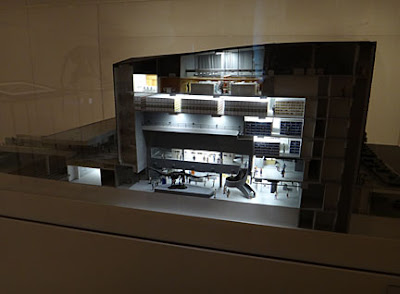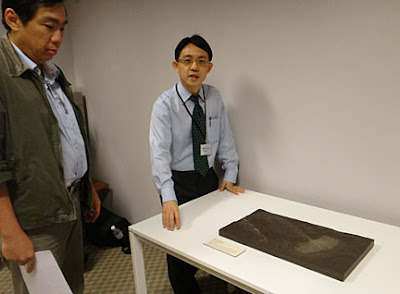Last week, I was very kindly invited to attend the groundbreaking ceremony for the construction of the museum.
The natural history museum will also house the 500,000 precious specimens that are an invaluable resource to scientific study in Singapore and around the world.
Here's a wide shot of the model. I can't wait for it to be built!
The ceremony was an opportunity for a group photo of the small, hard-working team who made the museum possible. And with everyone wearing nice clothes instead of field gear for a change!
Grumpy Prof Peter Ng is not amused that we hijacked his admin briefing for the impromptu group phot. A passionate leader in the project, Prof Peter has been working very hard to make the new museum a reality.
Here's Prof Leo Tan who is the indefatigable lead in raising funds and awareness for the new museum. He shows us one of the new fossils recently obtained for the new museum: the Narrow-finned Ichthyosaur, a predatory marine reptile with a streamlined body and shark-like tail that lived 185 million years ago.
And here's Dr Tan Swee Hee, another tireless key lead taking care of the zillions of details towards the realisation of the dream museum. He's with another special fossil: the Stalked-crinoid, an ancient relative of sea stars and sea urchins dating back to 185 million years ago. There was also a fossil of the Aeger Shrimp, a large well-preserved specimen from the Solnhofen deposits which dates back some 150 million years ago. All these fossils will be displayed at the new museum.
During the press briefing, more work by the small musem team. The curators and other staff at the museum double up as photographers, videographers, drivers, ushers and taking care of the endless myriad arrangements for the ceremony as well as other aspects of creating the museum.
There were lots of special people invited to the ground breaking ceremony, including former President SR Nathan, here with Ambassador and Mrs Joseph Koh. Ambassador Joseph is also Singapore's leading expert on spiders (he wrote the guide to Singapore spiders) and will be contributing his invaluable spider collection to the new museum! Also, Joseph was the one who first introduced me to nature and whom I blame for my current obsession with nature issues.
The President has a closer look at the Banded leaf monkey specimen that Kate Pocklington so magically restored. Here's a Straits Times feature on Kate's work. I learnt from some of the other participants that they didn't know Singapore still had this rare animal in our forests. More about Andie Ang's recent work on these monkeys and their current status.
Among the speakers at the event was Prof Tommy Koh who first started the conversation and push toward setting up a purpose-built natural history museum for Singapore. Among the incidents that led him to do so was his experience of the famed museums in the US, and his visit to the current tiny public gallery at the Raffles Museum of Biodiversity Research. It's inspiring to hear about how so many people made the new museum possible.
Then it was time for the groundbreaking ceremony, very cleverly arranged so the VIPs could remotely get the huge drilling rig to start on the work site.
Here's a look at the site, located next to the NUS museum and other key NUS facilities. These will all be integrated with the natural history museum to form an exciting precinct for students and the general public.
There's lots and lots of media present at the event. And Belinda Teo (in brown) is making sure everything is going smoothly.
Meanwhile, I had a great time hanging out with the media crew, who were also given a tour of the NUS museum which is currently showcasing some natural history museum specimens. Dr Joelle Lai gave us a great tour of the exhibits.
The treat of the day was to get a glimpse of the fabulous Fleming collection which represents about 95 per cent of butterflies in West Malaysia and Singapore. It was kindly acquired by Malaysian tycoon Tan Teong Hean. About 15 per cent of the butterflies in the collection can no longer be found. More about how the collection came home in the Straits Times report and a behind-the-scenes look by Mr Khew Sin Khoon, honorary curator at the Raffles Museum of Biodiversity Research.
Your help needed for the new museum!
While physically, the new natural history museum is taking shape, there is still much work get the 'software' into place. Prof Peter and Prof Leo will continue working hard to raise $10 million in endowment for professorships, fellowships and staff costs. The current museum is now operating with just two researchers and four curators. It will need to boost the team as the collection grows and the museum moves to its much larger, more public premises. It is looking at hiring at least half a dozen more of such staff, who will also take charge of teaching students.
You can donate to the museum online.
More ways to help!
Besides raising funds to pay for manpower, the museum is looking for donations in kind: collections of specimens such as the Fleming collection.
Ordinary people can also help get invaluable specimens by alerting the museum on roadkill.
Marcus Chua explains why this is useful on his post about the pangolin roadkill found recently. He explained earlier how a facebook post of a banded leaf monkey contributed to serious research on the monkey and current efforts to protect it. Also how roadkills were the only verifiable evidence of the presence of leopard cats in Singapore. Marcus is now seriously studying them.
Can the public see anything of the collection now?
Yes, but you must hurry. To prepare for the shift, existing Raffles Museum of Biodiversity Research's last day for public visits will be March 31. Displaying fascinating specimens from Singapore and beyond, here's more about what you can see at the gallery.
Opening hours: 9am-5pm, Mon to Fri, closed on Saturdays, Sundays and Public Holidays.
Location: Department of Biological Sciences, Faculty of Science, link to campus map.
Contact: 65-6516-5082
Guided and group tours of the Public Gallery is available, pre-registration required. More details on the RMBR website.
Get updates on the new museum via the RMBR news blog and Lee Kong Chian Natural History Museum facebook page.
Related links
- MORE about the new museum including:
- What's so special about our natural history collection?
- Why is this collection NOT displayed at the National Museum?
- Would people want to visit the new museum?
- Is a natural history museum important to conservation?
















